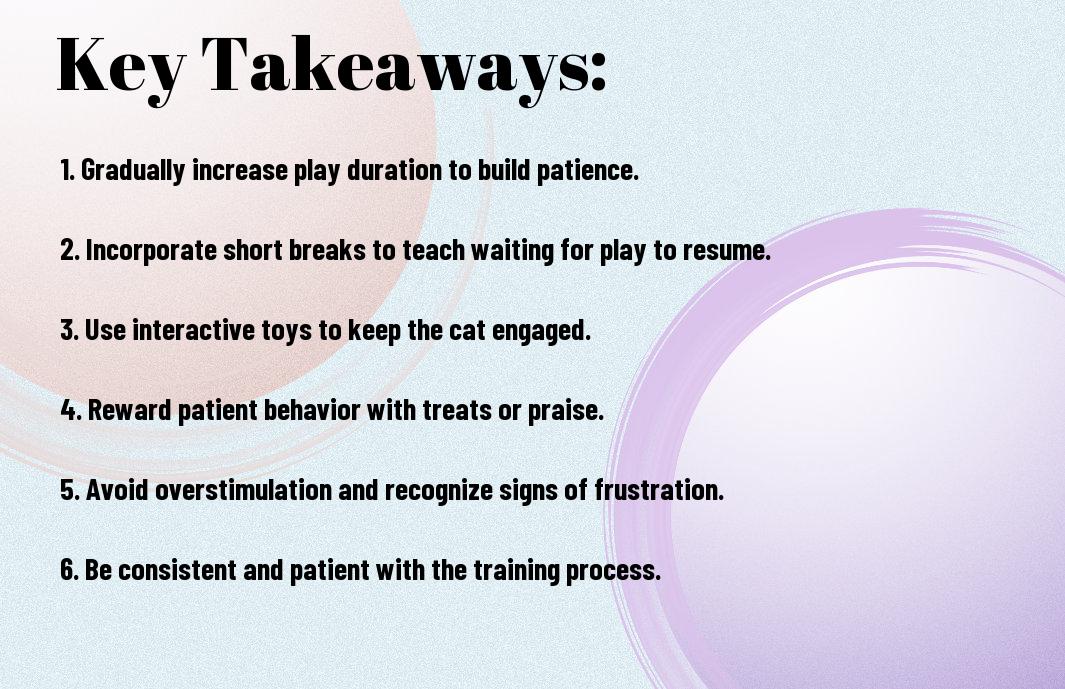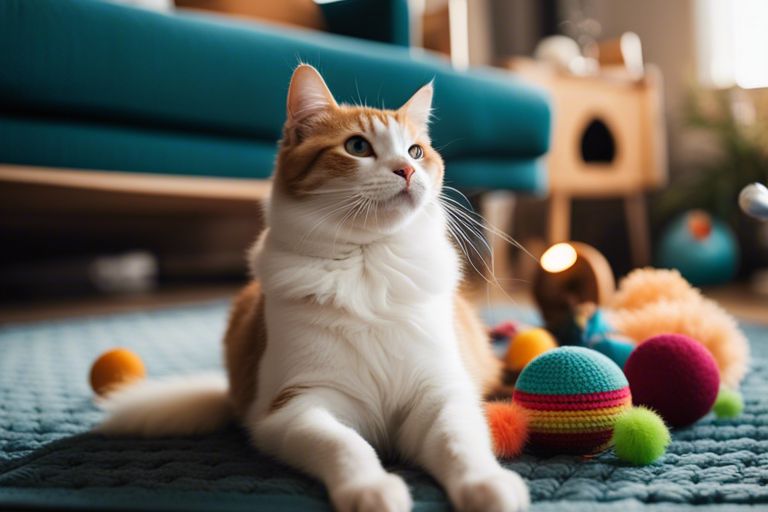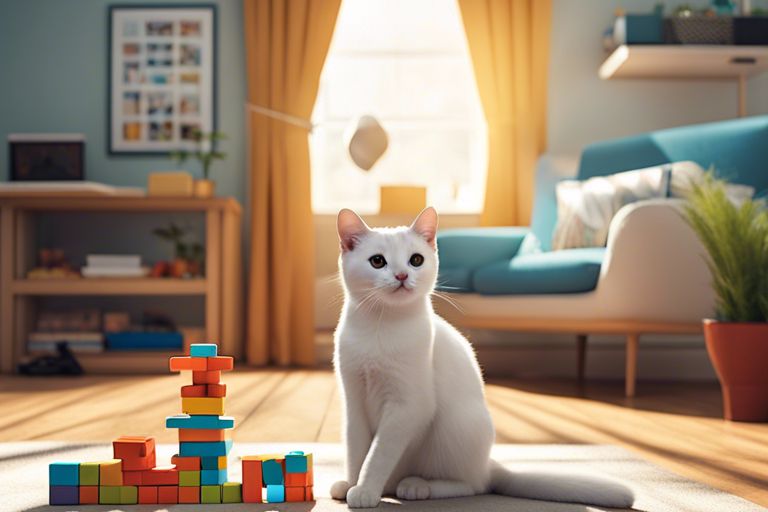Do you often find your feline friend getting a little too eager and rough during playtime? Teaching your cat to exhibit patience and gentleness during play is crucial for a harmonious and enjoyable bond between the two of you. It’s important to set clear boundaries and expectations, as well as provide the right type of toys and activities to engage your cat’s interest and tame their impulsive behavior. In this blog post, we will explore effective strategies for helping your cat become a more patient playtime companion.
Key Takeaways:
- Understand your cat’s behavior: Observing and understanding your cat’s behavior during playtime can help you identify triggers for impatience.
- Use interactive toys: Interactive toys can keep your cat engaged and reduce impatience during playtime.
- Give regular breaks: Allow your cat to take breaks during playtime to prevent overstimulation and impatience.
- Consistency is key: Establish a consistent playtime routine to help your cat learn when to expect play and when to be patient.
- Reward patience: Reward your cat for displaying patience during playtime to reinforce this behavior.


Establishing a Routine for Playtime
Clearly, establishing a routine for playtime is essential for teaching your cat to be more patient. Cats, like many animals, thrive on routine and predictability. When they know what to expect, they are more likely to be patient and less demanding during playtime. By setting a consistent schedule for play sessions, you can help your cat develop a sense of patience and anticipation for their playtime activities.
Consistency and Its Impact on Patience
Consistency is key when it comes to teaching your cat patience during playtime. When you consistently engage in play at the same time each day, your cat will come to expect and look forward to these sessions. This predictability can help reduce impatience and unruly behavior, as your cat learns that playtime will always come at a certain time. By maintaining a consistent schedule, you can help your cat develop the patience to wait for playtime rather than demanding attention at all hours of the day.
Creating a Structured Play Environment
When it comes to fostering patience in your cat during playtime, creating a structured play environment is crucial. By designating a specific area for playtime and keeping toys and interactive elements consistent, you can help your cat develop patience and focus during play. Set up a designated play area with toys and activities that your cat enjoys, and make sure the environment is free from distractions. By creating a structured and engaging play environment, you can encourage your cat to patiently engage in playtime activities without becoming overstimulated or impatient.
Remember, a consistent and structured playtime routine can help your cat develop patience and good behavior during play sessions. By providing a predictable schedule and a well-organized play area, you can help your cat learn to be patient and enjoy playtime in a controlled and positive manner.

Training Techniques to Enhance Patience
However, it can be challenging to teach a cat to be patient during playtime, especially if they are naturally highly energetic or easily frustrated. But with consistent training and positive reinforcement, you can help your feline friend develop better patience and impulse control. Here are some effective techniques to enhance your cat’s patience during playtime.
Incorporating Waiting Games
One effective way to teach your cat patience during playtime is to incorporate waiting games into their routine. For example, you can use interactive toys that require your cat to wait and observe before they can pounce or chase the toy. This helps them learn to control their impulses and wait for the right moment to engage in play. By incorporating waiting games into your playtime sessions, you can help your cat develop better patience and focus.
Positive Reinforcement and Rewards
Another effective technique to enhance your cat’s patience during playtime is to use positive reinforcement and rewards. Whenever your cat displays patience and self-control during play, be sure to reward them with praise, treats, or extra playtime. This will help your cat associate patience with positive outcomes, encouraging them to behave more patiently in the future.
Monitoring and Adjusting Your Approach
After implementing some initial strategies to teach your cat to be more patient during playtime, it’s important to monitor your cat’s behavior and adjust your approach as needed. Pay attention to how your cat responds to different play activities and take note of any signs of impatience or frustration.
Recognizing Signs of Impatience
When engaging in playtime with your cat, it’s crucial to be able to recognize signs of impatience. This can include your cat becoming agitated, swatting at toys aggressively, or vocalizing in a more intense manner. If you notice any of these behaviors, it’s important to immediately stop the play session and give your cat some space to calm down.
Adapting Play Strategies for Your Cat
Every cat is unique, and what works for one cat may not work for another. It’s essential to adapt your play strategies based on your cat’s individual preferences and behavior. If you notice that your cat becomes impatient with certain types of toys or activities, try switching things up and offering different options. Experiment with interactive toys, laser pointers, feather wands, or puzzle feeders to find the activities that keep your cat engaged without becoming impatient.
Additional Tips and Considerations
Despite your best efforts, some cats may naturally have shorter attention spans or less tolerance for playtime. In these cases, it can be helpful to adapt your approach and be patient with your pet. Here are some additional tips and considerations:
- Introduce new toys and activities to keep your cat engaged and interested
- Provide regular breaks during playtime to prevent overstimulation
- Be attentive to your cat’s body language and adjust your play accordingly
- Consider consulting with a veterinarian if your cat consistently displays impatience or aggression during play
Perceiving behavioral changes and seeking professional advice when necessary can make a significant impact on improving your cat’s patience during playtime.
Suitable Toys and Playtime Intervals
When teaching a cat to be more patient during playtime, it is important to consider the types of toys you are using and the intervals at which you engage with your pet. Interactive toys, such as feather wands and puzzle feeders, can provide mental stimulation and encourage better patience. Additionally, rotating your cat’s toys regularly can prevent boredom. As for playtime intervals, shorter, more frequent sessions may be more effective in maintaining your cat’s interest and patience.
Managing Overstimulation and Stress
Some cats may become overstimulated or stressed during playtime, leading to impatience and potential aggression. It is crucial to observe your cat’s behavior for signs of overstimulation, such as dilated pupils, flattened ears, and aggressive play. If you notice these signs, immediately cease play and allow your cat to relax. Providing a quiet, safe space for your cat to retreat to when feeling overwhelmed can also help in managing stress during playtime.
Teaching Your Cat to Be More Patient: Conclusion
Considering all points, it is evident that teaching a cat to be more patient during playtime requires consistency, positive reinforcement, and understanding your cat’s individual needs and preferences. By incorporating interactive toys, setting boundaries, and rewarding calm behavior, you can effectively teach your cat to be more patient and controlled during play. Remember to be patient and understanding yourself as you work to train your cat, and with time and effort, you will see improvement in your cat’s behavior.
FAQ
Q: How can I teach my cat to be more patient during playtime?
A: One effective way to teach your cat to be more patient during playtime is to establish a consistent routine. Set specific times for play sessions and stick to them. This will help your cat learn when to expect playtime and reduce its impatience. Additionally, using interactive toys, such as laser pointers and feather wands, can help channel your cat’s energy and teach it to wait for its turn to play.
Q: What are some training techniques to encourage patience in my cat during playtime?
A: Positive reinforcement is a key technique for teaching patience to your cat. When your cat displays patience during playtime, reward it with treats or praise. This will reinforce the behavior and encourage your cat to be more patient in the future. Another technique is to gradually increase the duration of play sessions, starting with short periods and gradually extending the time. This will help your cat learn to wait patiently for the next playtime.
Q: Are there any common mistakes to avoid when trying to teach patience to a cat during playtime?
A: One common mistake is using punishment or scolding to address impatience in your cat. This can create negative associations with playtime and may lead to behavioral issues. Instead, focus on positive reinforcement and patience-building techniques. It’s also important to be patient yourself and understand that teaching your cat to be patient during playtime takes time and consistency. Avoiding abrupt changes to the playtime routine and being mindful of your cat’s individual pace are also crucial to success.

Jayley, a devoted cat enthusiast, also writer for other cat blog as well. She aims to dedicated to providing comprehensive information, insights, and advice on everything you’d ever want to know about our whiskered companions.
